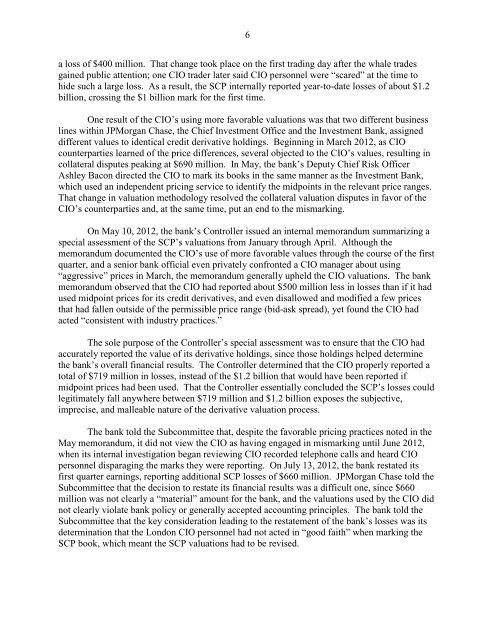JPMORGAN CHASE WHALE TRADES: A CASE HISTORY OF DERIVATIVES RISKS AND ABUSES
JPMORGAN CHASE WHALE TRADES: A CASE HISTORY OF DERIVATIVES RISKS AND ABUSES
JPMORGAN CHASE WHALE TRADES: A CASE HISTORY OF DERIVATIVES RISKS AND ABUSES
Create successful ePaper yourself
Turn your PDF publications into a flip-book with our unique Google optimized e-Paper software.
6<br />
a loss of $400 million. That change took place on the first trading day after the whale trades<br />
gained public attention; one CIO trader later said CIO personnel were “scared” at the time to<br />
hide such a large loss. As a result, the SCP internally reported year-to-date losses of about $1.2<br />
billion, crossing the $1 billion mark for the first time.<br />
One result of the CIO’s using more favorable valuations was that two different business<br />
lines within JPMorgan Chase, the Chief Investment Office and the Investment Bank, assigned<br />
different values to identical credit derivative holdings. Beginning in March 2012, as CIO<br />
counterparties learned of the price differences, several objected to the CIO’s values, resulting in<br />
collateral disputes peaking at $690 million. In May, the bank’s Deputy Chief Risk Officer<br />
Ashley Bacon directed the CIO to mark its books in the same manner as the Investment Bank,<br />
which used an independent pricing service to identify the midpoints in the relevant price ranges.<br />
That change in valuation methodology resolved the collateral valuation disputes in favor of the<br />
CIO’s counterparties and, at the same time, put an end to the mismarking.<br />
On May 10, 2012, the bank’s Controller issued an internal memorandum summarizing a<br />
special assessment of the SCP’s valuations from January through April. Although the<br />
memorandum documented the CIO’s use of more favorable values through the course of the first<br />
quarter, and a senior bank official even privately confronted a CIO manager about using<br />
“aggressive” prices in March, the memorandum generally upheld the CIO valuations. The bank<br />
memorandum observed that the CIO had reported about $500 million less in losses than if it had<br />
used midpoint prices for its credit derivatives, and even disallowed and modified a few prices<br />
that had fallen outside of the permissible price range (bid-ask spread), yet found the CIO had<br />
acted “consistent with industry practices.”<br />
The sole purpose of the Controller’s special assessment was to ensure that the CIO had<br />
accurately reported the value of its derivative holdings, since those holdings helped determine<br />
the bank’s overall financial results. The Controller determined that the CIO properly reported a<br />
total of $719 million in losses, instead of the $1.2 billion that would have been reported if<br />
midpoint prices had been used. That the Controller essentially concluded the SCP’s losses could<br />
legitimately fall anywhere between $719 million and $1.2 billion exposes the subjective,<br />
imprecise, and malleable nature of the derivative valuation process.<br />
The bank told the Subcommittee that, despite the favorable pricing practices noted in the<br />
May memorandum, it did not view the CIO as having engaged in mismarking until June 2012,<br />
when its internal investigation began reviewing CIO recorded telephone calls and heard CIO<br />
personnel disparaging the marks they were reporting. On July 13, 2012, the bank restated its<br />
first quarter earnings, reporting additional SCP losses of $660 million. JPMorgan Chase told the<br />
Subcommittee that the decision to restate its financial results was a difficult one, since $660<br />
million was not clearly a “material” amount for the bank, and the valuations used by the CIO did<br />
not clearly violate bank policy or generally accepted accounting principles. The bank told the<br />
Subcommittee that the key consideration leading to the restatement of the bank’s losses was its<br />
determination that the London CIO personnel had not acted in “good faith” when marking the<br />
SCP book, which meant the SCP valuations had to be revised.



